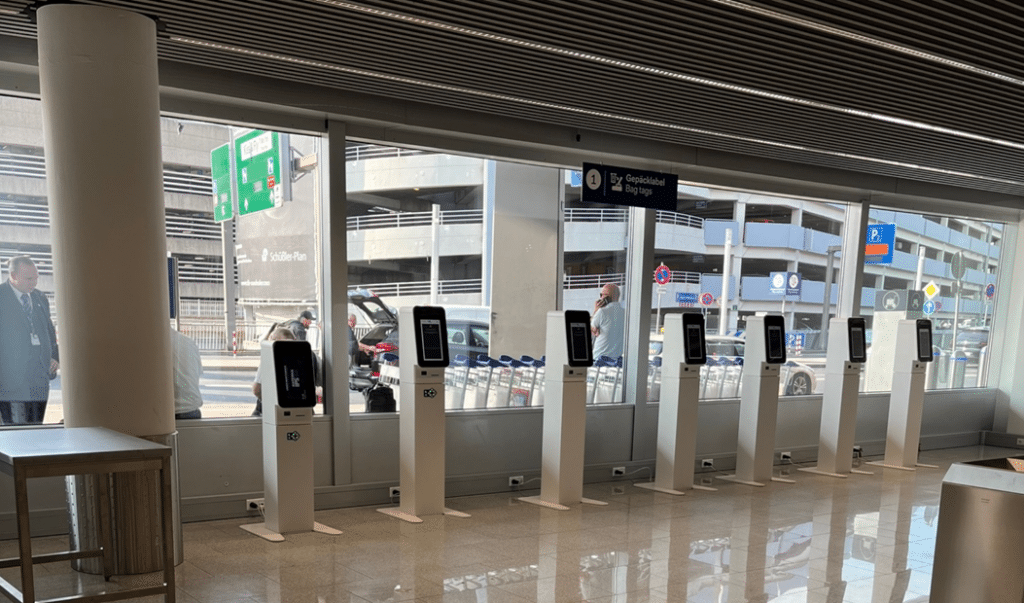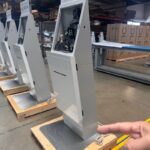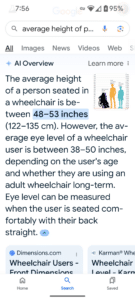Standing Tall – Does ADA Discriminate?
Editors Note: Being able to think critically about ADA is good practice. There are many forms of accessibility and many of those are ignored in favor of the more popular. The writer is expressing their own opinion and not Kiosk Industry Group/Self Service Kiosk Machine. Discussion was stimulated (see comments below) and that was outcome we sought.
About the Writer: Christoph Nussbaumer is the CEO of REINGroup based in Austria. Alpine Kiosk boasts a diverse array of designs, each is highly adaptive and radiating elegance and sophistication. Alpine Kiosk – Where each design is a testament to premium craftsmanship. Alpine Kiosk is Gold Supporter of Kiosk Industry Group and member of the KMA Kiosk Association. His viewpoint from Europe and US is invaluable. His viewpoint and opinion is his own.
Recently, I attended the Passenger Terminal Expo in Frankfurt, Germany. I spoke with most of the self-check-in kiosk manufacturers and found out that many intend to build only ADA-compliant kiosks in the future. They worried about the risk involved if a wheelchair user caannot immediately find an accessible kiosk, so better make them all ADA.
This raises an important question: Is this approach practical? Should ADA regulations specify a percentage of kiosks that must be wheelchair accessible? Is it discriminatory if a company installs only ADA kiosks?
Consider this scenario:
A visually impaired person who is 6 foot one (1.85 meters) tall is at an airport searching for a self-check-in kiosk. The ADA-compliant kiosk’s screen is set very low, with the Storm ADA interface even lower. The ticket and bag tag printers are nearly at ground level (seen in real life at the Passenger Terminal Expo in Frankfurt).
Nowadays, most kiosks at ADA height have a Storm interface or other tactile/voice/sound input/output possibilities, but standard height ones do not. Again, a tall visually impaired person might not be happy. Isn’t this discriminatory towards a visually impaired person?
A few statistics:
50% of the U.S. population is over 1.68 meters tall and 25% are over 1.75 meters tall. For all these people, whether disabled or not, using a low kiosk is uncomfortable.
My Call for AIA!!!
I advocate for the Americans Inclusion Act (AIA), which would ensure that self-service devices are designed for all people. It shouldn’t be permissible to have kiosks set only at wheelchair height. There should be a rule specifying what percentage of kiosks should be at ADA height and what percentage at standard height.
Ergonomics at the Workplace
Over decades, workplace ergonomics have evolved and, in some cases, been codified into regulations or laws. Why should these principles be ignored for self-service kiosks?
An ADA kiosk is currently uncomfortable for the average person or at least for 25-50% of the population. Therefore, a “one size fits all” approach is not practical; we need kiosks at two different heights.
Neck Problems in Younger Generations Due to Smartphone Use
Studies show that younger generations are developing neck problems from looking down at their phones. We are repeating this with ADA kiosks and tilted screens, requiring users to look down. The only ergonomically correct and comfortable way is to look straight at a vertical screen, or if tilted, at a comfortable height.
Height-Adjustable Kiosks as an Alternative?
This seems like a good theoretical solution. It meets ADA legal requirements, but in practice, it may fall short. Self-service kiosks aim to increase efficiency and customer flow, so they need to be quick to use.
Height-adjustable kiosks, like adjustable desks, are usually motorized. Imagine standing in line, waiting as each person adjusts the height (cue motor noise). Waiting 10 seconds can feel like an eternity. And what are the additional costs of these height-adjustable kiosks?
The Department of Transportation (DOT) and Airports:
Interestingly, the Department of Transportation (DOT) already mandates that at least 25% of all kiosks in airports be accessible. This higher percentage ensures better accessibility and reduces wait times for individuals with disabilities. So, why doesn’t ADA make similar clear requirements for all environments?
Conclusion:
A one-size-fits-all concept is impractical. Dear manufacturers, please don’t offer your clients only ADA-compliant kiosks. That has nothing to do with ergonomics!
Recommend a certain percentage of ADA kiosks and make some kiosks at standard height with a convenient Storm ADA interface – 50% of visually impaired people over 1.68 meters will thank you. To the ADA committee, please specify in your guidelines what percentage of kiosks at a location should be wheelchair accessible. The term “sufficient” is not specific enough.
Comments Welcomed – Discussion is a Good Thing
- Seriously, the old adage I hear thrown around all the time is “tall people can bend down”. At 6’-1” I’m not super tall, but tall enough that ADA compliant Kiosks are often hard to use. I recall being in Italy last summer and using a Kiosk set way above ADA and thinking how luxurious it was to not bend over. But I also think that way about tall showers, taller bathroom counter tops and the like. This world is not well tailored to the tall. Frank Olea
- I do believe one size can fit all when Universal Design Principles are applied at the concept phase of development. And I don’t think pushing a button to adjust the height of a kiosk would critically impact the queue time, it’s a matter of seconds not minutes. The idea though, that the solution is modification instead of innovation, is what gets us stuck. What if a kiosk sensed the position of the user? Possibilities open up when the design is based on the user experience with full inclusion at the beginning. Also, I feel like percentages [what percent of kiosk should be ADA] is a futile discussion, there will never be consensus. Moreover, how is it an equitable experience when a user has to hunt for the kiosk that will “work” for them? Will there be kiosks for people using wheelchairs and those who are short, a few for people with sight loss, and then some for tall people too? Imagine if spell check was only available on two of the office computers! Universal Design benefits everyone. MJ Barry, Dolphin Computer Access
- Craig Keefner — Seems like always exceptions. One of the complaints about the Little Clinic check-in kiosks is that some find them too short. This is Colorado and maybe people are higher than the base the ADA standards used (5 foot 4″ is my guess but I will check.
- Craig Keefner — Philippe Boileau With increased use of cameras many have to crouch to get in focus. Eye level for a woman at 64″ still has to “reach” down to the 48 (or 44) max. I understand the most good for the most people but the min/max parameters still have problems. THere are short urinals in bathrooms but not all of them are short. The 48 reach is generally derived from person in wheelchair extending arm. Also consider less than 3% of US public uses a wheelchair. Its a tough equation no matter how you view it.
- Frank Olea — Is it at all possible that ADA compliant kiosks are not inclusive to tall
people? I’m 6’-1” and when I stand in front of my own product I have to stoop and I’m not really “tall”. We build this check in kiosk for a very large healthcare chain and they got complaints from taller patients, so they had us make a riser for some of the kiosks that go out to accommodate taller patients. Christoph Nussbaumer recently wrote an article about it and it started a lot of debate with us Kiosk types. See image to the right. If I were to guess I would say Kaiser Permanente
- See Little Clinics in Kroger article. One of the complaints is unit is too short. It is Elo model and it is perfect ADA spec.
- Thread on Linkedin
- Chad Behling, PMPView Sr. PMP Certified Project Manager & Program Manager – When I worked at Uber and was helping run kiosk pilots, we utilized a stool for taller people to confortably use the kiosk but the experience was different as they were mostly used for driver onboarding, which took more time than something like check in.
- Netherlands and Germany are the tallest. https://en.m.wikipedia.org/wiki/Average_human_height_by_country
Useful Links
- ADA Standard (US and Europe) – covers the entire range of standards
- More Kiosk ADA Standards
- height as a disability: Let’s not overreact — grounds to sue are based on a physical impairment must be a physiological disorder or condition.
Related Links
- Epic Welcome Kiosk That is Truly Height Adjustable
- FAQ Kiosk ADA
- Fact Sheet 4. Tax Incentives for Improving Accessibility – ADA.gov
- ADA For Restaurants – Accessible Retail Spaces Webinar




